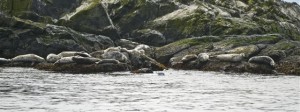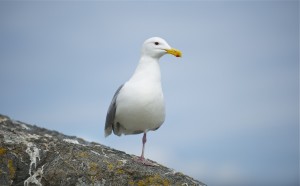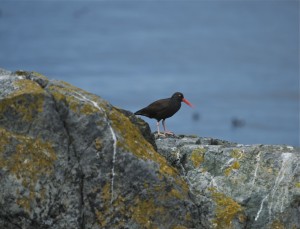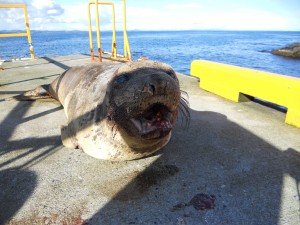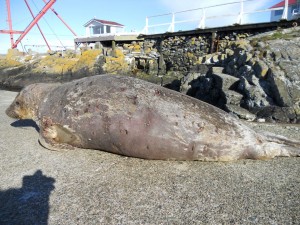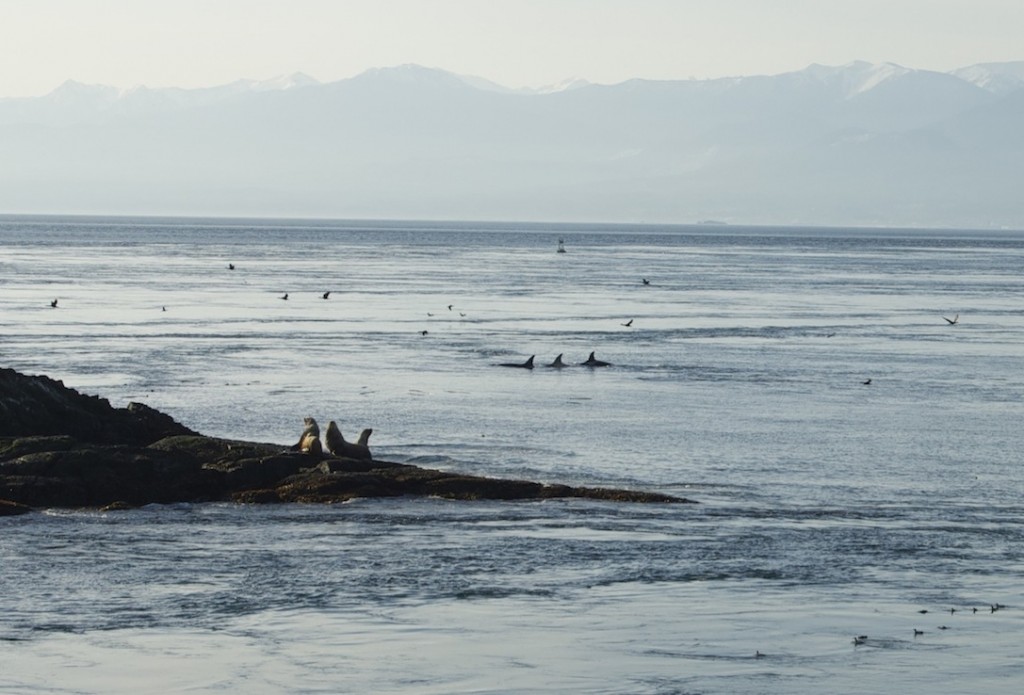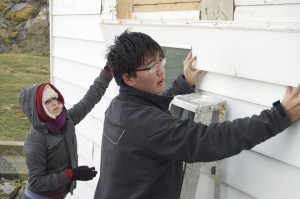Species and Number
Tag Archives: harlequin duck
Animal Census Apr 18, 2012
Stellar Sea Lion – 20
Elephant Seal – 12
Harbour Seal – 200
Glaucous-winged Gull – 200
Brandt’s Cormorant – 250
Pelagic Cormorant – 10
Black Turnstones – 30 w/ 2 juveniles
Surfbirds – 10
Raven – 4
Crow – 1
Dunlin – 2
Sparrows – 6
Pigeon Guillemots – 150
Harlequin Ducks – 100
Canada Goose – 20
Bald Eagle (adult) – 4 (juvenile) 8
Black Oyster-catcher – 40
34 people have visited in the least 2 weeks
Moulting Time
There are about 8-10 young and mostly moulting elephant seals in the reserve at this time. Between four and six have been lounging on the pier creating obstacles for the group of 10 students that spent the weekend here. The grumpy infected girl at the end of the dock made all of us clamber around the outside of the rail to get to and from the boat. Today I thought she looked a bit better. There appears to be an object imbedded in her lower palate; perhaps a barb or spine from a fish she was hunting. I hope it works it’s way out in time. Presumably elephant seals are pretty durable creatures… we will keep a close eye on her recuperation.
The students did a great job of weeding the scotch thistles from around the tower.
There are plenty of Pigeon Guillemots and Black Oystercatcher pairs on the island, with a few Harlequin ducks and Rhinoceros Auklets just offshore. The Harbour Seals should start giving birth soon. There is a large pregnant female on the foreshore near the engine room.
3 rental boats entered the reserve and broke all the rules for respectable human decorum here. I called the marina and they quickly responded by phoning the renters to warn them of their infractions. I was happy to see them promptly exit the reserve and head off towards the military ballistics range.
Bird and Mammal Count
For Sunday March 25:
Black Oyster Catcher (Haematopus bachmani): 7 pairs
Canada Goose (Branta canadensis): 3
Surfbirds (Aphriza virgata): 100+
Cormorants (Phalacrocorax penicilatu, P. pelagicus, and/or P.auritas): 200+
Gulls (mostly Larus glaucescens): 230+
Pigeon Guillemots (Cepphus columba): 30+
Harlequin Ducks (Histrionicus histrionicus): 5
Harbour Seals (Phoca vitulina) : 30+ S islands
Northern Sea Lions (Eumetopisa jubatus): 14 S islands, 1 Middle Rocks
Elephant Seals (Mirounga angustirostris): 3 Middle Rocks, 1 Great Race
Orcas (Orcinus orca): 8 in the morning going E between S Islands and Rosedale Reef Buoy
Project Week-part 3 (final)
Yesterday was the last day of project week, in the morning I brought students back to campus in two trips on the whaler. It has been great group to have out here for the past week, they have helped out with several projects and tasks, endured some stormy weather, survived without a shower, cooked their own food (and shared a few good meals 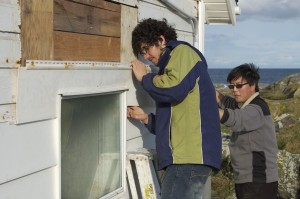 with me), and experienced the isolation and richness of the Race Rocks Ecological Reserve. During their stay they were very conscious of the time and resources required for importing fuel and generating energy and fresh water and did a great job minimizing consumption and waste.
with me), and experienced the isolation and richness of the Race Rocks Ecological Reserve. During their stay they were very conscious of the time and resources required for importing fuel and generating energy and fresh water and did a great job minimizing consumption and waste.
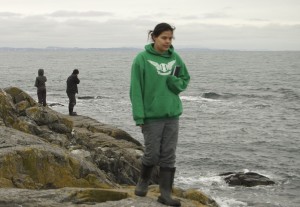 In the final days of the week students helped out with transferring diesel to the furnace tanks and cleaning cupboards in the science centre kitchen. Throughout the week the group maintained a daily count of animals in the reserve, the count is included below.
In the final days of the week students helped out with transferring diesel to the furnace tanks and cleaning cupboards in the science centre kitchen. Throughout the week the group maintained a daily count of animals in the reserve, the count is included below.
| Feb 27 | Feb 28 | Feb 29 | Mar 1 | Mar 2 | Mar 3 | |
| Harbor seals | 45 | 50 | 10 | 22 | 20 | 16 |
| Elephant seals | 2 | 2 | 2 | 2 | 2 | 2 |
| Sea lions | 2 | 5 | 5 | 5 | 6 | 6 |
| Gulls | 57 | 23 | 33 | 43 | 31 | 26 |
| Cormorants | 60 | 27 | 29 | 40 | 56 | 32 |
| Oyster Catchers | 3 | 5 | 3 | 6 | 7 | |
| Bald Eagles | 1 | 1 | 1 | |||
| Brown Sandpiper | 4 | 12 | 8 | 6 | ||
| White Sandpiper | 5 | 3 | 4 | |||
| Pigeon Guillemots | 22 | 150 | ||||
| Common Mergansers | 2 | |||||
| Harlequin Ducks | 12 | 7 | 6 |
Thanks to the group for their contributions and good company.
Camera 5 working
The remote camera on the N side of the Great Race is working now, you can access it here: www.racerocks.com/racerock/video5.htm
Note: there are 20 presets which cover all major points in a 300 degree view.
Squall has been staying around the SE side of the tower. Misery comes and goes, the pup usually keeps out of his reach.
Yesterday there were 2 eco-tour vessels in the reserve.
Facility work: replaced toilet vent fan, replacing basement basin drain plumbing, planning composting containers.
Bird count today: 6 Harlequin ducks, 150 Cormorants, and 90 gulls.
Wind 20- 30 knots from the west all day, rainy.
Animal Census Jan 2012
Air Breathing Animal Census of Race Rocks Jan 2012
Stellar Sea Lions: 30
Elephant Seals: 6-7
Harbour Seals: 50
Bald Eagles: 5-15
Brandt’s Cormorants: 50
Glaucous-Winged Gull: 100
Herring Gull: 30
Black Turnstones: 50
Song Sparrow: 6
Peregrine Flacon: 1
Killdeer: 4
Dunlin: 2
Sandpiper: 6
Harlequin Ducks: 20
Human: 1
Cormorants, Elephant Seals, Fuel Line, Plumbing Parts
This morning I counted over 200 cormorants on the South Rocks and saw a pair of Harlequin ducks by the jetty.
The female elephant 6360 went back in the water before noon. Misery was near the centre of the island at sunset.
I went off island to campus around noon. I brought some scientific instruments back to campus and went into Langford to pick up plumbing parts and other supplies. Erik worked on the whaler’s fuel line over the afternoon and got it fixed up. I got back out to the island as the sun was setting on the lowest tide I have ever landed on out here, the boat ramp was longer than usual.
Harlequin Ducks put off by DND Blasting
14 Harlequin Ducks have arrived at Race Rocks and are making good use of the fine weather this past week. Unfortunately, these shy birds have been scared away today by bomb blasts on Bentinck Island. Blasting by CFAD Rocky Point has been continuous today with the exception of a lunch break at noon. It is very disappointing that the 5-minute interval designed to minimize DND impact on the ecological reserve has not been observed. Most blasts come in clusters with ~2-minute intervals. The blasting occurring around the time of this report ~13:54 had ~1-minute intervals.
Black Oystercatcher nests
-110, ‘2010-06-21’, ‘Other’, 0, ‘As we officially kick off summer, I thought I ”d give a bit of an update on life on the island right now. The black oystercatcher chicks have hatched in the nest up beside the jetty and down off the tank room! While outside doing some cleanup yesterday morning, I spotted at least one chick, and I suspect there may be more, as there were three eggs in total. This hatching brings some relief, as all of us were quite worried about this nest. Mother oystercatcher had not been spending as much time on her nest as she should have, what with the high traffic transiting the area. However, last week I cordoned off the area with large ropes and she settled down a lot, just in time for the hatching. I also set up camera 3 beside the nest; it can be viewed at http://www.racerocks.com/racerock/video3.htm. I apologize in advance for the moisture on the lens; we ”ve had some high winds and rain over the last day and it has become a bit dirty. At this point though, I ”m a bit apprehensive to get close and clean it, as it ”s really only a foot away from the nest. There are at least two other nests on the island with chicks; one in the surge channel facing the southeast, and one in the channel facing the southwest. In other news, Bertha has decided to make a reappearance on the island after a few days off in the water somewhere. She is hauled up in her favourite spot behind the tank room. Her bad eye is looking worse than ever, and is dripping quite a lot of serum. #4252 is up beside the base of the lighthouse, on the side adjacent to the desalinator bunker, and seems to be enjoying the shelter of the long grasses. Misery is up around the science house somewhere. From the house this morning, I also noticed a possibly fourth, middle-aged, female elephant seal making her way up from the boat ramp -it may have been Bertha though, it ”s hard to tell). Yesterday, three harlequin ducks were spotted in the southeast surge channel, sitting contentedly on rocks. There appeared to be two males and one female. I took some pictures yesterday, but am not sure if they turned out because of the distance. Check on my Flickr site later: http://www.flickr.com/photos/adamharding/. Most seagulls have now settled down into their nests, with a few still mating. Nest numbers seem to be down from this time last year. Enjoy the solstice!’, ‘adam’, ’07:57:59 ,

